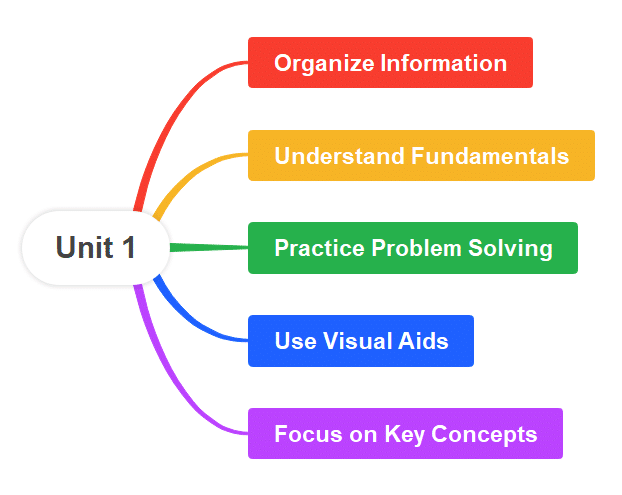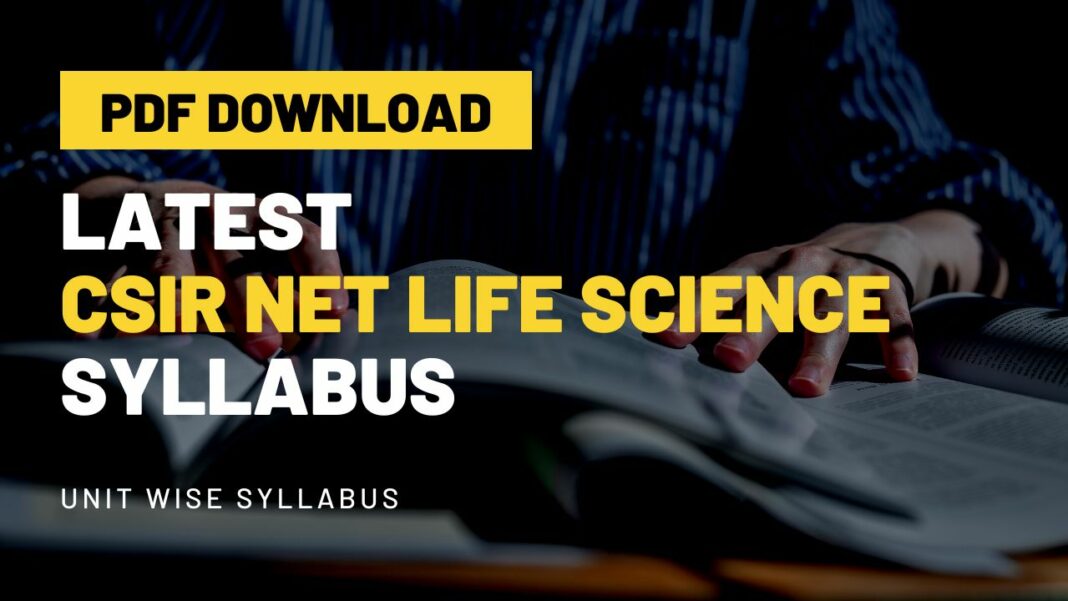The latest CSIR NET Syllabus for Life Sciences PDF is a must-have for all the aspirants targeting the CSIR NET Life Science exam 2024-25. Unless you know the destination and the way to reach it, can you reach there? No, Right! Similarly, for aspirants targeting the CSIR NET Life Science exam, knowing the ins and outs of the syllabus is very important if one wants to qualify for the exam in one shot. The CSIR NET Life Science syllabus is humungous. It consists of 13 UNITS, and each UNIT can be an individual course / full-time degree in itself.
Without a proper study plan & smart strategy to cover this vast syllabus, conquering the exam can be a far-fetched dream for many. Below, we have tried to simplify the CSIR NET Syllabus in the easiest way possible for the convenience of all aspirants.
Table of Contents
Latest CSIR NET Syllabus For Life Sciences 2024-25
CSIR NET Life Science exam syllabus consists of 13 UNITS related to core subjects. It begins with an exploration of molecules and their interactions relevant to biology (Unit 1) and progresses through cellular organization (Unit 2), fundamental processes (Unit 3), cell communication and signaling (Unit 4), developmental biology (Unit 5), and system physiology for both plants (Unit 6) and animals (Unit 7). The syllabus further delves into inheritance biology (Unit 8), diversity of life forms (Unit 9), ecological principles (Unit 10), evolution and behavior (Unit 11), applied biology (Unit 12), and methods in biology (Unit 13). The diverse topics themselves reflect the difficulty level of the exam. Thus, aspirants must strategize smartly to cover the important & significant portion of the syllabus.
Download the Latest CSIR NET Life Science Syllabus PDF
| S. No. | Topic |
|---|---|
| UNIT 1 | Molecules and their Interaction Relevant to Biology |
| UNIT 2 | Cellular Organization |
| UNIT 3 | Fundamental Processes |
| UNIT 4 | Cell Communication and Cell Signaling |
| UNIT 5 | Developmental Biology |
| UNIT 6 | System Physiology – Plant |
| UNIT 7 | System Physiology – Animal |
| UNIT 8 | Inheritance Biology |
| UNIT 9 | Diversity of Life Forms |
| UNIT 10 | Ecological Principles |
| UNIT 11 | Evolution and Behavior |
| UNIT 12 | Applied Biology |
| UNIT 13 | Methods in Biology |
CSIR NET LIFE SCIENCE IMPORTANT TOPICS – COMPLETE LIST
UNIT WISE CSIR NET SYLLABUS for Life Sciences
| Unit Number | Unit Title | Download Link |
|---|---|---|
| CSIR NET UNIT 1 | Molecules and their Interaction Relevant to Biology | Download PDF |
| CSIR NET UNIT 2 | Cellular Organization | Download PDF |
| CSIR NET UNIT 3 | Fundamental Processes | Download PDF |
| CSIR NET UNIT 4 | Cell Communication and Cell Signaling | Download PDF |
| CSIR NET UNIT 5 | Developmental Biology | Download PDF |
| CSIR NET UNIT 6 | System Physiology – Plant | Download PDF |
| CSIR NET UNIT 7 | System Physiology – Animal | Download PDF |
| CSIR NET UNIT 8 | Inheritance Biology | Download PDF |
| CSIR NET UNIT 9 | Diversity of Life Forms | Download PDF |
| CSIR NET UNIT 10 | Ecological Principles | Download PDF |
| CSIR NET UNIT 11 | Evolution and Behavior | Download PDF |
| CSIR NET UNIT 12 | Applied Biology | Download PDF |
| CSIR NET UNIT 13 | Methods in Biology | Download PDF |
CSIR NET Syllabus Unit 1 – MOLECULES AND THEIR INTERACTION RELEVANT TO BIOLOGY
The syllabus starts with CSIR NET UNIT 1, which encompasses key aspects of chemistry and biochemistry, including atomic and molecular structures, chemical bonds, biomolecule composition and function, stabilizing interactions, biophysical chemistry principles, bioenergetics, catalysis principles, protein and nucleic acid conformation, stability, and metabolism of biomolecules.
| CSIR NET UNIT 1 | Topics |
|---|---|
| A. Structure of Atoms, Molecules, and Chemical Bonds | – Atomic structure – Molecular structure – Types of chemical bonds (ionic, covalent, metallic) – Molecular geometry |
| B. Composition, Structure, and Function of Biomolecules | – Carbohydrates – Lipids – Proteins – Nucleic acids – Vitamins |
| C. Stabilizing Interactions | – Van der Waals forces – Electrostatic interactions – Hydrogen bonding – Hydrophobic interactions |
| D. Principles of Biophysical Chemistry | – pH and buffer systems – Reaction kinetics – Thermodynamics – Colligative properties |
| E. Bioenergetics | – Glycolysis – Oxidative phosphorylation – Coupled reactions – Group transfer – Biological energy transducers |
| F. Principles of Catalysis | – Enzymes – Enzyme kinetics – Enzyme regulation – Mechanism of enzyme catalysis – Isozymes |
| G. Conformation of Proteins | – Ramachandran plot – Secondary structure (alpha helix, beta sheet) – Domains – Motifs and folds |
| H. Conformation of Nucleic Acids | – Helical structures (A, B, Z) – t-RNA – Micro-RNA |
| I. Stability of Proteins and Nucleic Acids | – Protein stability – Nucleic acid stability |
| J. Metabolism of Biomolecules | – Carbohydrate metabolism – Lipid metabolism – Amino acid metabolism – Nucleotide metabolism – Vitamin metabolism |
Tips for studying CSIR NET UNIT 1:

- Organize Information: Create a structured outline or mind map to organize the topics and their interconnections visually.
- Understand Fundamentals: Ensure a strong understanding of basic concepts in atomic and molecular structure, chemical bonds, and biomolecules.
- Practice Problem Solving: Solve problems related to reaction kinetics, thermodynamics, and other quantitative aspects to reinforce theoretical knowledge.
- Use Visual Aids: Utilize diagrams, charts, and models to understand complex structures and interactions, especially in topics like protein conformation and nucleic acid structures.
- Focus on Key Concepts: Identify key principles in each subtopic and focus on mastering them before delving into detailed nuances.
CSIR NET Syllabus for Unit 2 – CELLULAR ORGANIZATION
CSIR NET UNIT 2 includes below mentioned topics: membrane structure and function, intracellular organelles, organization of genes and chromosomes, cell division, and microbial physiology. Topics include lipid bilayers, organelle functions, gene organization, cell cycle regulation, and microbial growth strategies.
| CSIR NET UNIT 2 | Topics |
|---|---|
| A) Membrane Structure and Function | – Structure of model membrane – Lipid bilayer and membrane protein diffusion – Osmosis – Ion channels – Active transport – Membrane pumps – Mechanism of sorting and regulation of intracellular transport – Electrical properties of membranes |
| B) Structural Organization and Function of Intracellular Organelles | – Cell wall – Nucleus – Mitochondria – Golgi bodies – Lysosomes – Endoplasmic reticulum – Peroxisomes – Plastids – Vacuoles – Chloroplast – Structure & function of the cytoskeleton and its role in motility |
| C) Organization of Genes and Chromosomes | – Operon – Unique and repetitive DNA – Interrupted genes – Gene families – Structure of chromatin and chromosomes – Heterochromatin – Euchromatin – Transposons |
| D) Cell Division and Cell Cycle | – Mitosis and meiosis, their regulation – Steps in the cell cycle – Regulation and control of cell cycle |
| E) Microbial Physiology | – Growth yield and characteristics – Strategies of cell division – Stress response |
Study tips for CSIR NET UNIT 2: Create visual aids for organelle structures, focus on gene organization principles, understand cell cycle regulation intricacies, and apply stress response strategies in microbial physiology for effective preparation.
CSIR NET Syllabus for Unit 3 – FUNDAMENTAL PROCESSES
CSIR NET UNIT 3 focuses on DNA replication, repair, recombination, RNA synthesis and processing, protein synthesis and processing, and control of gene expression. Topics include replication machinery, transcription factors, translation processes, and gene regulation mechanisms.
| CSIR NET UNIT 3 Syllabus | Topics |
|---|---|
| A) DNA Replication, Repair, and Recombination | – Unit of replication – Enzymes involved – Replication origin and replication fork – Fidelity of replication – Extrachromosomal replicons – DNA damage and repair mechanisms – Homologous and site-specific recombination |
| B) RNA Synthesis and Processing | – Transcription factors and machinery – Formation of initiation complex – Transcription activator and repressor – RNA polymerases – Capping, elongation, and termination – RNA processing, editing, splicing, and polyadenylation – Structure and function of different types of RNA – RNA transport |
| C) Protein Synthesis and Processing | – Ribosome – Formation of initiation complex – Initiation factors and their regulation – Elongation and elongation factors – Termination – Genetic code – Aminoacylation of tRNA – tRNA-identity, aminoacyl tRNA synthetase, and translational proofreading – Translational inhibitors – Post-translational modification of proteins |
| D) Control of Gene Expression | – Regulation of phages, viruses, prokaryotic, and eukaryotic genes – Role of chromatin in gene expression and gene silencing – Transcription and translation level control |
Study tips for CSIR NET UNIT 3: Create timelines for DNA processes, practice identifying key components in RNA and protein synthesis, understand genetic code intricacies, explore various gene expression regulatory mechanisms, and use mnemonic devices for effective memorization.
UNIT 4 CSIR NET Syllabus – Cell Communication and Cell Signaling
CSIR NET UNIT 4 covers host-parasite interactions, cell signaling, cellular communication, cancer, and the innate and adaptive immune system. Topics include pathogen recognition, cell signaling pathways, cancer genetics, and immune responses.
| CSIR NET UNIT 4 | Topics |
|---|---|
| A) Host-Parasite Interaction | – Recognition and entry processes of different pathogens (bacteria, viruses) into animal and plant host cells – Alteration of host cell behavior by pathogens – Virus-induced cell transformation – Pathogen-induced diseases in animals and plants – Cell-cell fusion in both normal and abnormal cells |
| B) Cell Signaling | – Hormones and their receptors – Cell surface receptor – Signaling through G-protein coupled receptors – Signal transduction pathways – Second messengers – Regulation of signaling pathways – Bacterial and plant two-component systems – Light signaling in plants – Bacterial chemotaxis and quorum sensing |
| C) Cellular Communication | – Regulation of hematopoiesis – General principles of cell communication – Cell adhesion and roles of different adhesion molecules – Gap junctions – Extracellular matrix – Integrins – Neurotransmission and its regulation |
| D) Cancer | – Genetic rearrangements in progenitor cells – Oncogenes – Tumor suppressor genes – Cancer and the cell cycle – Virus-induced cancer – Metastasis – Interaction of cancer cells with normal cells – Apoptosis – Therapeutic interventions of uncontrolled cell growth |
| E) Innate and Adaptive Immune System | – Cells and molecules involved in innate and adaptive immunity – Antigens, antigenicity, and immunogenicity – B and T cell epitopes – Structure and function of antibody molecules – Generation of antibody diversity – Monoclonal antibodies – Antibody engineering – Antigen-antibody interactions – MHC molecules – Antigen processing and presentation – Activation and differentiation of B and T cells – B and T cell receptors – Humoral and cell-mediated immune responses – Primary and secondary immune modulation – The complement system – Toll-like receptors – Cell-mediated effector functions – Inflammation – Hypersensitivity and autoimmunity – Immune response during bacterial (tuberculosis), parasitic (malaria), and viral (HIV) infections – Congenital and acquired immunodeficiencies – Vaccines |
Study tips CSIR NET UNIT 4: Focus on understanding signaling pathways in detail, use visual aids for immune system processes, relate cancer mechanisms to cell cycle regulation, practice identifying key components of host-parasite interactions, and create summaries for effective revision.
CSIR NET Syllabus for Unit 5 – DEVELOPMENTAL BIOLOGY
CSIR NET UNIT 5 explores basic concepts of development, including potency, commitment, and differentiation, along with topics like gametogenesis, fertilization, early development, morphogenesis, organogenesis in animals and plants. The unit also covers programmed cell death, aging, and senescence.
| CSIR NET UNIT 5 Syllabus | Topics |
|---|---|
| A) Basic Concepts of Development | – Potency, commitment, specification, induction, competence, determination, and differentiation – Morphogenetic gradients – Cell fate and cell lineages – Stem cells – Genomic equivalence and cytoplasmic determinants – Imprinting – Mutants and transgenics in the analysis of development |
| B) Gametogenesis, Fertilization, and Early Development | – Production of gametes – Cell surface molecules in sperm-egg recognition in animals – Embryo sac development and double fertilization in plants – Zygote formation, cleavage, blastula formation, embryonic fields, gastrulation, and formation of germ layers in animals – Embryogenesis, establishment of symmetry in plants – Seed formation and germination |
| C) Morphogenesis and Organogenesis in Animals | – Cell aggregation and differentiation in Dictyostelium – Axes and pattern formation in Drosophila, amphibia, and chick – Organogenesis – vulva formation in Caenorhabditis elegans, eye lens induction, limb development, and regeneration in vertebrates – Differentiation of neurons, post-embryonic development – larval formation, metamorphosis – Environmental regulation of normal development – Sex determination |
| D) Morphogenesis and Organogenesis in Plants | – Organization of shoot and root apical meristem – Shoot and root development – Leaf development and phyllotaxy – Transition to flowering, floral meristems, and floral development in Arabidopsis and Antirrhinum |
| E) Programmed Cell Death, Aging, and Senescence |
Study tips For CSIR NET UNIT 5: Create concept maps for developmental processes, understand key signaling molecules in gametogenesis, use model organisms for analysis, and relate environmental factors to organogenesis. Practice identifying stages in embryonic development for effective preparation.
CSIR NET UNIT 6 Syllabus – SYSTEM PHYSIOLOGY – PLANT
Under CSIR NET UNIT 6 one can find topics like – photosynthesis, respiration, nitrogen metabolism, plant hormones, sensory photobiology, solute transport, photoassimilate translocation, secondary metabolites, and stress physiology in plants. Topics include light harvesting complexes, nitrogen assimilation, hormone effects, and plant responses to various stresses.
| CSIR NET UNIT 6 | Topics |
|---|---|
| A) Photosynthesis | – Light harvesting complexes – Mechanisms of electron transport – Photoprotective mechanisms – CO2 fixation – C3, C4, and CAM pathways |
| B) Respiration and Photorespiration | – Citric acid cycle – Plant mitochondrial electron transport and ATP synthesis – Alternate oxidase – Photorespiratory pathway |
| C) Nitrogen Metabolism | – Nitrate and ammonium assimilation – Amino acid biosynthesis |
| D) Plant Hormones | – Biosynthesis, storage, breakdown, and transport – Physiological effects and mechanisms of action |
| E) Sensory Photobiology | – Structure, function, and mechanisms of action of phytochromes, cryptochromes, and phototropins – Stomatal movement – Photoperiodism and biological clocks |
| F) Solute Transport and Photoassimilate Translocation | – Uptake, transport, and translocation of water, ions, solutes, and macromolecules – Transpiration – Mechanisms of loading and unloading of photoassimilates |
| G) Secondary Metabolites | – Biosynthesis of terpenes, phenols, and nitrogenous compounds – Roles of secondary metabolites |
| H) Stress Physiology | – Responses of plants to biotic (pathogen and insects) and abiotic (water, temperature, and salt) stresses |
Study tips for CSIR NET UNIT 6: Utilize visual aids for understanding complex pathways, focus on key steps in photosynthesis and respiration, create flashcards for hormone actions, and relate stress responses to specific physiological changes. Regularly practice with diagrams and models to reinforce concepts.
CSIR NET Syllabus Unit 7 – SYSTEM PHYSIOLOGY – ANIMAL
CSIR NET UNIT 7 covers blood and circulation, cardiovascular system, respiratory system, nervous system, sense organs, excretory system, thermoregulation, stress and adaptation, digestive system, and endocrinology and reproduction. Topics include blood composition, cardiac anatomy, neural control of respiration, sensory responses, kidney function, thermoregulation, and endocrine regulation.
| CSIR NET UNIT 7 | Topics |
|---|---|
| A) Blood and Circulation | – Blood corpuscles, haemopoiesis, and formed elements – Plasma function, blood volume, blood volume regulation – Blood groups, haemoglobin, immunity, haemostasis |
| B) Cardiovascular System | – Comparative anatomy of heart structure – Myogenic heart, specialized tissue – ECG – its principle and significance – Cardiac cycle, heart as a pump – Blood pressure, neural and chemical regulation |
| C) Respiratory System | – Comparison of respiration in different species – Anatomical considerations – Transport of gases, exchange of gases – Waste elimination, neural and chemical regulation of respiration |
| D) Nervous System | – Neurons, action potential – Gross neuroanatomy of the brain and spinal cord – Central and peripheral nervous system – Neural control of muscle tone and posture |
| E) Sense Organs | – Vision, hearing, and tactile response |
| F) Excretory System | – Comparative physiology of excretion – Kidney, urine formation – Urine concentration, waste elimination, micturition – Regulation of water balance, blood volume, blood pressure – Electrolyte balance, acid-base balance |
| G) Thermoregulation | – Comfort zone, body temperature – physical, chemical, neural regulation – Acclimatization |
| H) Stress and Adaptation | |
| I) Digestive System | – Digestion, absorption – Energy balance, BMR |
| J) Endocrinology and Reproduction | – Endocrine glands – Basic mechanism of hormone action – Hormones and diseases – Reproductive processes, gametogenesis, ovulation – Neuroendocrine regulation |
Study tips for CSIR NET UNIT 7: Use diagrams to understand physiological processes, focus on key regulatory mechanisms, create mnemonic devices for hormone functions, and practice with case studies to apply concepts in diverse contexts. Regularly review and reinforce your understanding through self-assessment quizzes.
CSIR NET Syllabus for Unit 8- INHERITANCE BIOLOGY
CSIR NET UNIT 8 includes: Mendelian principles, gene concepts, extensions of Mendelian principles, gene mapping methods, extra-chromosomal inheritance, microbial genetics, human genetics, quantitative genetics, mutation, structural and numerical alterations of chromosomes, and recombination. Topics include gene interactions, pedigree analysis, mutation types, and chromosome alterations.
| CSIR NET UNIT 8 Syllabus | Topics |
|---|---|
| A) Mendelian Principles | – Dominance – Segregation – Independent assortment |
| B) Concept of Gene | – Allele – Multiple alleles – Pseudoallele – Complementation tests |
| C) Extensions of Mendelian Principles | – Codominance – Incomplete dominance – Gene interactions – Pleiotropy – Genomic imprinting – Penetrance and expressivity – Phenocopy – Linkage and crossing over – Sex linkage – Sex-limited and sex-influenced characters |
| D) Gene Mapping Methods | – Linkage maps – Tetrad analysis – Mapping with molecular markers – Mapping by using somatic cell hybrids – Development of mapping population in plants |
| E) Extra Chromosomal Inheritance | – Inheritance of mitochondrial and chloroplast genes – Maternal inheritance |
| F) Microbial Genetics | – Methods of genetic transfers – transformation, conjugation, transduction, and sexduction – Mapping genes by interrupted mating – Fine structure analysis of genes |
| G) Human Genetics | – Pedigree analysis – Lod score for linkage testing – Karyotypes – Genetic disorders |
| H) Quantitative Genetics | – Polygenic inheritance – Heritability and its measurements – QTL mapping |
| I) Mutation | – Types, causes, and detection – Mutant types – lethal, conditional, biochemical, loss of function, gain of function – Germinal versus somatic mutants – Insertional mutagenesis |
| J) Structural and Numerical Alterations of Chromosomes | – Deletion – Duplication – Inversion – Translocation – Ploidy and their genetic implications |
| K) Recombination | – Homologous and non-homologous recombination including transposition |
Study tips for CSIR NET UNIT 8: Use Punnett squares for Mendelian principles, practice gene mapping techniques, apply quantitative genetics concepts to solve problems, and analyze pedigree charts for human genetics. Utilize visual aids to understand chromosome alterations and recombination processes.
CSIR NET Syllabus Unit 9 – DIVERSITY OF LIFE FORMS
CSIR NET UNIT 9 of life science syllabus covers topics like principles and methods of taxonomy, levels of structural organization, outline classification of plants, animals, and microorganisms, natural history of the Indian subcontinent, organisms of health and agricultural importance, and organisms of conservation concern. Topics include biological nomenclature, comparative anatomy, and conservation strategies.
| CSIR NET UNIT 9 | Topics |
|---|---|
| A) Principles & Methods of Taxonomy | – Concepts of species and hierarchical taxa – Biological nomenclature – Classical & quantitative methods of taxonomy of plants, animals, and microorganisms |
| B) Levels of Structural Organization | – Unicellular, colonial, and multicellular forms – Levels of organization of tissues, organs & systems – Comparative anatomy, adaptive radiation, adaptive modifications |
| C) Outline Classification of Plants, Animals & Microorganisms | – Important criteria used for classification in each taxon – Classification of plants, animals, and microorganisms – Evolutionary relationships among taxa |
| D) Natural History of Indian Subcontinent | – Major habitat types of the subcontinent – Geographic origins and migrations of species – Common Indian mammals, birds – Seasonality and phenology of the subcontinent |
| E) Organisms of Health & Agricultural Importance | – Common parasites and pathogens of humans, domestic animals, and crops |
| F) Organisms of Conservation Concern | – Rare, endangered species – Conservation strategies |
Study tips for CSIR NET UNIT 9: Create mnemonic devices for taxonomy criteria, use diagrams for structural organization, relate classification to evolutionary relationships, and stay updated on conservation efforts. Practice identifying common organisms of health and agricultural importance for practical application.
CSIR NET Syllabus Unit 10 – ECOLOGICAL PRINCIPLES
CSIR NET UNIT 10 includes these topics: environmental topics, including habitat and niche concepts, population ecology, species interactions, community ecology, ecological succession, ecosystem ecology, biogeography, applied ecology, and conservation biology. Subjects include population growth, community structure, and biodiversity management.
| CSIR NET UNIT 10 | Topics |
|---|---|
| The Environment | – Physical environment – Biotic environment – Biotic and abiotic interactions |
| Habitat and Niche | – Concept of habitat and niche – Niche width and overlap – Fundamental and realized niche – Resource partitioning – Character displacement |
| Population Ecology | – Characteristics of a population – Population growth curves – Population regulation – Life history strategies (r and K selection) – Concept of metapopulation – demes and dispersal, interdemic extinctions, age-structured populations |
| Species Interactions | – Types of interactions – Interspecific competition – Herbivory – Carnivory – Pollination – Symbiosis |
| Community Ecology | – Nature of communities – Community structure and attributes – Levels of species diversity and its measurement – Edges and ecotones |
| Ecological Succession | – Types – Mechanisms – Changes involved in succession – Concept of climax |
| Ecosystem Ecology | – Ecosystem structure – Ecosystem function – Energy flow and mineral cycling (C, N, P) – Primary production and decomposition – Structure and function of some Indian ecosystems: terrestrial (forest, grassland) and aquatic (freshwater, marine, estuarine) |
| Biogeography | – Major terrestrial biomes – Theory of island biogeography – Biogeographical zones of India |
| Applied Ecology | – Environmental pollution – Global environmental change – Biodiversity: status, monitoring, and documentation – Major drivers of biodiversity change – Biodiversity management approaches |
| Conservation Biology | – Principles of conservation – Major approaches to management – Indian case studies on conservation/management strategy (Project Tiger, Biosphere reserves) |
Study tips for CSIR NET UNIT 10: Develop a clear understanding of ecological concepts, use case studies for applied ecology, and create visual aids for ecosystem structures. Practice analyzing population growth curves and understanding the dynamics of ecological succession. Stay informed on environmental issues for a holistic approach to the topics.
CSIR NET Syllabus Unit 11 – EVOLUTION AND BEHAVIOUR
CSIR NET UNIT 11 covers topics like the emergence of evolutionary thoughts, origin of cells and unicellular evolution, paleontology and evolutionary history, molecular evolution, mechanisms of evolution, and the relationship between brain, behavior, and evolution. Topics include Lamarckian concepts, the Miller-Urey experiment, molecular clocks, mechanisms of evolution, and behavioral aspects.
| CSIR NET UNIT 11 syllabus | Topics |
|---|---|
| A) Emergence of Evolutionary Thoughts | – Lamarck – Darwin–concepts of variation, adaptation, struggle, fitness, and natural selection – Mendelism – Spontaneity of mutations – The evolutionary synthesis |
| B) Origin of Cells and Unicellular Evolution | – Origin of basic biological molecules – Abiotic synthesis of organic monomers and polymers – Concept of Oparin and Haldane – Experiment of Miller (1953) – The first cell – Evolution of prokaryotes – Origin of eukaryotic cells – Evolution of unicellular eukaryotes – Anaerobic metabolism, photosynthesis, and aerobic metabolism |
| C) Paleontology and Evolutionary History | – The evolutionary time scale – Eras, periods, and epochs – Major events in the evolutionary time scale – Origins of unicellular and multicellular organisms – Major groups of plants and animals – Stages in primate evolution including Homo |
| D) Molecular Evolution | – Concepts of neutral evolution, molecular divergence, and molecular clocks – Molecular tools in phylogeny, classification, and identification – Protein and nucleotide sequence analysis – Origin of new genes and proteins – Gene duplication and divergence |
| E) The Mechanisms | – Population genetics – Populations, Gene pool, Gene frequency – Hardy-Weinberg Law – Concepts and rate of change in gene frequency through natural selection, migration, and random genetic drift – Adaptive radiation – Isolating mechanisms – Speciation – Allopatricity and Sympatricity – Convergent evolution – Sexual selection – Co-evolution |
| F) Brain, Behavior, and Evolution | – Approaches and methods in the study of behavior – Proximate and ultimate causation – Altruism and evolution-Group selection, Kin selection, Reciprocal altruism – Neural basis of learning, memory, cognition, sleep, and arousal – Biological clocks – Development of behavior – Social communication – Social dominance – Use of space and territoriality – Mating systems, Parental investment, and Reproductive success – Parental care – Aggressive behavior – Habitat selection and optimality in foraging – Migration, orientation, and navigation – Domestication and behavioral changes |
CSIR NET Syllabus Unit 12 – APPLIED BIOLOGY
CSIR NET UNIT 12 covers microbial fermentation and production, the application of immunological principles in vaccines and diagnostics, transgenic animals and plants, genomics and its applications in health and agriculture, bioresource utilization and biodiversity, breeding in plants and animals, bioremediation and phytoremediation for environmental cleanup, and the application of biosensors.
| CSIR NET UNIT 12 | Topics |
|---|---|
| A) Microbial Fermentation and Production | – Small and macro molecules production through microbial fermentation |
| B) Application of Immunological Principles | – Vaccines – Diagnostics – Tissue and cell culture methods for plants and animals |
| C) Transgenic Animals and Plants | – Molecular approaches to diagnosis and strain identification |
| D) Genomics and Its Application | – Health and agriculture applications – Gene therapy |
| E) Bioresource and Uses of Biodiversity | – Utilization of biodiversity in biotechnology |
| F) Breeding in Plants and Animals | – Marker-assisted selection |
| G) Bioremediation and Phytoremediation | – Environmental cleanup using biological methods |
| H) Biosensors | – Application of biosensors in various fields |
Study tips for CSIR NET UNIT 12: Focus on practical applications of immunological principles, understand molecular approaches in genomics, and explore real-world examples of bioremediation and biosensor applications. Practice linking concepts to their practical implications for a comprehensive understanding.
CSIR NET SYLLABUS Unit 13 – METHODS IN BIOLOGY
CSIR NET UNIT 13 includes topics like molecular biology and recombinant DNA methods, histochemical and immunotechniques, biophysical methods, statistical methods, radiolabeling techniques, microscopic techniques, electrophysiological methods, and methods in field biology. Topics include DNA sequencing, molecular cloning, immunoprecipitation, statistical analysis, radiolabeling, microscopy, electrophysiology, and field biology methods.
| CSIR NET UNIT 13 | Topics |
|---|---|
| A) Molecular Biology and Recombinant DNA Methods | – Isolation and purification of RNA, DNA (genomic and plasmid), and proteins – Different separation methods – Analysis of RNA, DNA, and proteins by one and two-dimensional gel electrophoresis, Isoelectric focusing gels – Molecular cloning of DNA or RNA fragments in bacterial and eukaryotic systems – Expression of recombinant proteins using bacterial, animal, and plant vectors – Isolation of specific nucleic acid sequences – Generation of genomic and cDNA libraries in plasmid, phage, cosmid, BAC, and YAC vectors – In vitro mutagenesis and deletion techniques, gene knockout in bacterial and eukaryotic organisms – Protein sequencing methods, detection of post-translation modification of proteins – DNA sequencing methods, strategies for genome sequencing – Methods for analysis of gene expression at RNA and protein level, large-scale expression, such as microarray-based techniques – Isolation, separation, and analysis of carbohydrate and lipid molecules – RFLP, RAPD, and AFLP techniques |
| B) Histochemical and Immunotechniques | – Antibody generation – Detection of molecules using ELISA, RIA, western blot, immunoprecipitation, flow cytometry, and immunofluorescence microscopy – Detection of molecules in living cells, in situ localization by techniques such as FISH and GISH |
| C) Biophysical Method | – Molecular analysis using UV/visible, fluorescence, circular dichroism, NMR, and ESR spectroscopy – Molecular structure determination using X-ray diffraction and NMR – Molecular analysis using light scattering, different types of mass spectrometry, and surface plasma resonance methods |
| D) Statistical Methods | – Measures of central tendency and dispersal – Probability distributions (Binomial, Poisson, and normal) – Sampling distribution – Difference between parametric and non-parametric statistics – Confidence Interval – Errors – Levels of significance – Regression and Correlation – t-test – Analysis of variance – X2 test – Basic introduction to Multivariate statistics, etc. |
| E) Radiolabeling Techniques | – Detection and measurement of different types of radioisotopes normally used in biology – Incorporation of radioisotopes in biological tissues and cells – Molecular imaging of radioactive material – Safety guidelines |
| F) Microscopic Techniques | – Visualization of cells and subcellular components by light microscopy – Resolving powers of different microscopes – Microscopy of living cells – Scanning and transmission microscopes – Different fixation and staining techniques for EM – Freeze-etch and freeze-fracture methods for EM – Image processing methods in microscopy |
| G) Electrophysiological Methods | – Single neuron recording – Patch-clamp recording – ECG – Brain activity recording – Lesion and stimulation of the brain – Pharmacological testing – PET, MRI, fMRI, CAT |
| H) Methods in Field Biology | – Methods of estimating population density of animals and plants – Ranging patterns through direct, indirect, and remote observations – Sampling methods in the study of behavior – Habitat characterization: ground and remote sensing methods |
Study tips for CSIR NET UNIT 13: Practice hands-on techniques in molecular cloning and immune techniques, understand principles of biophysical methods, utilize statistical tools for data analysis, and explore applications of electrophysiological methods. Familiarize yourself with microscopic techniques and their applications, and gain practical experience in field biology methods.
































